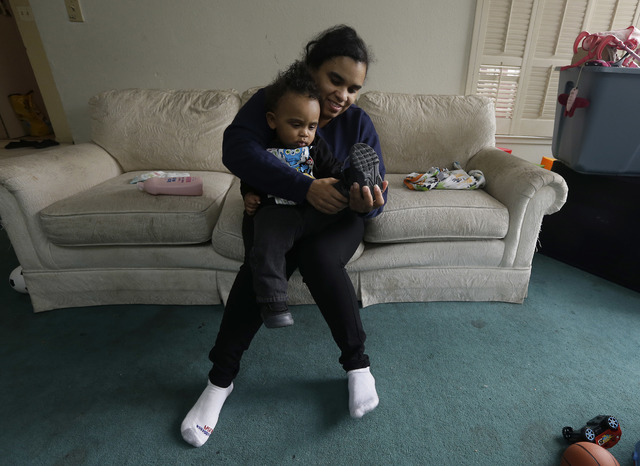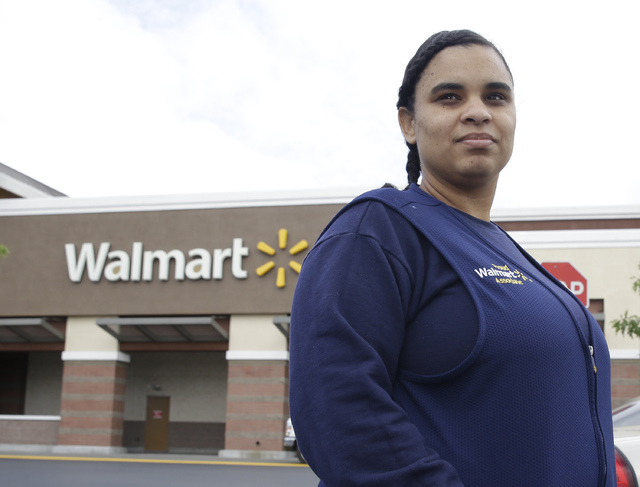NEW YORK (AP) — For Shannon Henderson, getting a cold or flu could be the difference between putting food on the table and going hungry.
NEW YORK (AP) — For Shannon Henderson, getting a cold or flu could be the difference between putting food on the table and going hungry.
As a part-time customer service representative at a Wal-Mart in Sacramento, California, Henderson is one of an estimated 40 million American workers for who calling in sick is a luxury. If they don’t work, they don’t get paid.
“I’m super afraid of getting sick,” said Henderson, 29, who slathers on hand sanitizer at work in hopes of fending off illness.
Paid sick leave is the next frontier in the fight for the country’s lowest earners. Some of the same workers’ rights groups that grabbed headlines recently by pushing companies for wage hikes are steering the conversation toward paid sick leave. The debate has caught the attention of governments and companies alike.
President Barack Obama is calling for federal legislation that would require companies to guarantee workers paid sick days. And since San Francisco started requiring that in 2007, nearly 20 cities and three states — Connecticut, Massachusetts and California — have passed similar measures. New York, Maryland and other states are considering laws too. And McDonald’s Corp. and Wal-Mart Stores Inc., which have announced wage hikes recently, are making changes to their paid sick leave policies.
“Paid sick days are a job issue,” said Ellen Bravo, executive director for Family Values Work, a network of coalitions fighting to pass paid sick days and family leave policies. “When you don’t have sick pay, you get docked.”
The new focus comes amid wide disparities between the benefits received by the top and bottom rungs of the corporate ladder. Sixty-one percent of U.S. workers get at least one paid sick day, according to a national compensation survey of employee benefits conducted last year by the Bureau of Labor Statistics.
But only 20 percent of workers whose wages are at the bottom 10 percent get paid sick leave, compared with 87 percent in the top 10 percent. There’s also a difference when comparing part-time and full-time employees: Seventy-four percent of full-time workers get paid sick leave, while 24 percent of part-time workers do, according to BLS.
Despite the disparities, some industry groups are fighting against laws requiring sick leave pay. Lisa Horn, director of congressional affairs at Society for Human Resource Management, a human resource management trade group, says many companies are leaning toward policies that lump sick, personal and vacation days together. But she says laws force companies to scale back on those benefits to keep down the costs associated with people taking sick days off.
“These mandates have a chilling effect on employers’ ability to innovate and be creative with their leave options,” she said.
Eileen Appelbaum, senior economist at Center for Economic and Policy Research, says mandated sick pay has not had a negative impact on some companies that have been surveyed. According to a survey the group did of businesses in Connecticut, which has required paid sick leave since 2012, one-third of workers took no paid sick leave. “They treat them as insurance,” she said.
Big companies with operations nationwide are changing their paid sick leave policies ahead of legislation.
In February, Wal-Mart, the largest U.S. private employer, said within about a year it would end the one-day wait for sick pay for all full-time U.S. workers. That’s a change from the current system that requires Wal-Mart workers in the U.S. to wait a day to use sick days, which means they have to use personal days on the first day out sick. (Full-time workers can earn up to two personal days and about six days of sick leave pay a year.)
Randy Hargrove, a Wal-Mart spokesman, said the company also is reviewing its sick policy for part-time workers, who account for half of its 1.3 million-person workforce in the U.S. Currently, if part-time workers are ill, they have to use personal days.
McDonald’s is taking a different approach by lumping personal and sick days together. Starting July 1, full-time and part-time workers at company-owned restaurants will begin to accrue personal paid time off after one year of service that can be used for sick leave.
An employee working an average of 20 hours a week will be eligible to accrue about 20 hours of paid time off a year. If employees don’t take the earned time off, they will be paid for the value of it. The benefits apply to only McDonald’s company-owned restaurants, which represent about 10 percent of its more than 14,300 restaurants nationwide.
“We’ve listened to our employees and learned that — in addition to increased wages — paid personal leave … would make a real difference in their careers and lives,” McDonald’s President and CEO Steve Easterbrook said in a statement.
Workplace experts expect other companies to follow Wal-Mart and McDonald’s. “More employers are voluntarily adopting paid sick leave programs,” says Mark Girouard, an employment attorney at Nilan Johnson Lewis who represents national retailers.
That is welcome news to workers who struggle to make ends meet when they take a sick day.
Henderson, the customer service rep, works under the 34 hours per week average that would make her a Wal-Mart full-time employee, so the company’s policy change doesn’t affect her. She said she’s looking forward to California’s sick leave mandate, which goes into effect in July and allows workers one hour of paid sick leave for every 30 hours worked.
The single mother of an infant makes $10 a week — an annual paycheck of a little over $16,000. Henderson, who says she can’t afford to take time off, has gone to work with a runny nose and no voice. But last year, she said she took time off when she was pregnant because of morning sickness.
“We are human,” said Henderson, who is a member of a labor-backed group OUR Walmart, which has pressed the retailer for higher wages and expanded benefits. “We can’t control being sick.”


